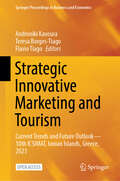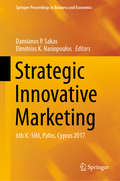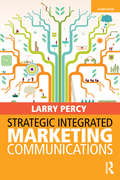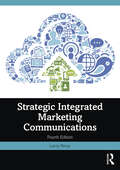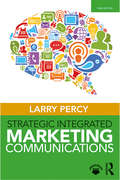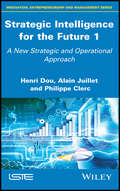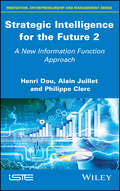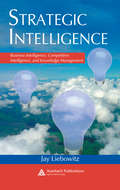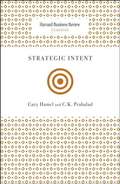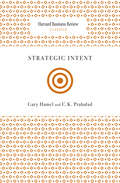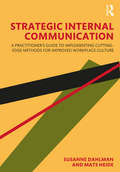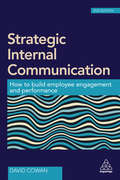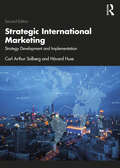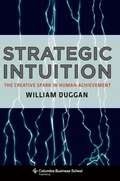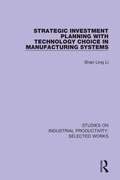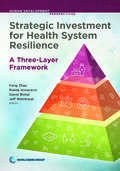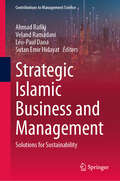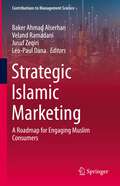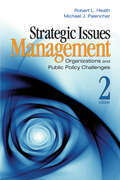- Table View
- List View
Strategic Innovative Marketing and Tourism: Creative Solutions and Digital Transformation Challenges—11th ICSIMAT, Brasov, Romania, 2024 (Springer Proceedings in Business and Economics)
by Androniki Kavoura Victor-Alexandru Briciu Arabela BriciuThis open access book presents the latest findings of researchers from around the globe who presented their work at the 11th International Conference of Strategic Innovative Marketing and Tourism (ICSIMAT) in 2024. It provides an up-to-date information and discusses current trends, issues, and debates, both theoretical and practical research, on strategic innovative marketing and tourism and applications from social media and emerging technologies in Artificial Intelligence and the Internet of Everything. Topics covered in the chapters include social media in marketing and tourism hospitality, culture, strategic tools, and techniques employed and implemented by some of the top research laboratories in the world to the industry. This book brings together work from both academia and industry and continues the successful impact of the previous years' conference on the academic discussion of the topics.
Strategic Innovative Marketing and Tourism: Current Trends and Future Outlook—10th ICSIMAT, Ionian Islands, Greece, 2023 (Springer Proceedings in Business and Economics)
by Androniki Kavoura Teresa Borges-Tiago Flavio TiagoThis open access book presents the latest findings of researchers from around the globe who presented their work at the 10th international conference of Strategic Innovative Marketing and Tourism (ICSIMAT) in 2023. It provides an up-to-date information and discusses current trends, issues, and debates, both theoretical and practical research, on strategic innovative marketing and tourism and applications from social media and emerging technologies in Artificial Intelligence and the Internet of Everything. Topics covered in the chapters include social media in marketing and tourism hospitality, culture, strategic tools, and techniques employed and implemented by some of the top research laboratories in the world to the industry. This book brings together work from both academia and industry and continues the successful impact of the previous years' conference on the academic discussion of the topics.
Strategic Innovative Marketing: 6th IC-SIM, Pafos, Cyprus 2017 (Springer Proceedings in Business and Economics)
by Damianos P. Sakas Dimitrios K. NasiopoulosThis proceedings volume highlights cutting-edge approaches for contemporary issues evolved in strategic marketing and the integration of theory and practice. It focuses on strategic research and innovative activities in marketing that can be used in everyday operations. The contributions have been divided into eight sections, grouping emerging marketing technologies together in a close examination of practices, problems and trends. The first section examines management challenges which influence societies, cultures, networks, organizations, teams, and individuals. It emphasizes ways business processes foster innovation and facilitate management transitions from dominant structures to more evolutionary, developmental paradigms. The second section discusses the benefits and guidelines to implementation of green marketing strategies. The following section pursues new perspectives of the role of location in marketing and its impact on consumer well-being. The next section explores the impacts of user generated content (UGC) on marketing theories and practice, which is followed by a section identifying how market-based assets can contribute to a sustainable competitive advantage. The sixth section covers understanding consumer perception to make marketing decisions. The final sections promote the use of business informatics and modeling in marketing and also the development of integrating information management in ways that change how people use information to engage in knowledge focused activities. The papers from the proceedings of the 6th International Conference on Strategic Innovative Marketing (IC-SIM 2017) have been written by scientists, researchers, practitioners and students that demonstrate a special orientation in strategic marketing, all of whom aspire to be ahead of the curve based on the pillars of innovation. This proceedings volume shares their recent contributions to the field and showcases their exchange of insights on strategic issues in the science of innovation marketing.
Strategic Integrated Marketing Communications
by Larry PercyAn essential book for today's marketer now that integrated marketing communications form a critical success factor in building strong brands and strong companies This new edition is still the only textbook on the market to deal with all aspects of IMC from a strategic perspective Corporate image, identity and reputation have never been more important and this book unlocks the key factors in achieving and enhancing this Integrated Marketing Communications is not just about utilizing different communication options in your marketing campaign; it is about planning in a systematic way to determine the most effective and consistent message for your target audience. As such, it depends upon identifying the best positioning, generating positive brand attitude, a consistent reinforcement of the brand's message through IMC channels, and ensuring that all marketing communication supports the company's overall identity, image, and reputation. This textbook is a roadmap to achieving this, thoroughly updated to reflect the dynamic changes in the area since the first edition was published. New to this edition: New sections on social media and now to integrate them into your marketing function New chapter on message development and an enhanced chapter on the IMC plan Robust pedagogy to help reinforce learning and memory Enhanced teaching materials online to help lecturers prepare their courses Brand new real-life case study vignettes
Strategic Integrated Marketing Communications
by Larry PercyThis book provides a disciplined, systematic look at what is necessary to the planning and implementation of an effective Integrated Marketing Communications (IMC) programme. Throughout, attention is paid to balancing theory with practical application, how to successfully implement theory for effective communication. Step-by-step, knowledge and understanding builds through the book, starting by laying a foundation to provide context, looking at the role of IMC in building brands and strengthening companies. The book then considers what goes into developing and executing effective messages, and how to ensure that they are consistent and consistently delivered, regardless of media. A detailed, practical overview of the strategic planning process is provided, illustrated by numerous examples and cases, along with ‘desktop’ tools and worksheets for developing and implementing an IMC plan. The 4th edition of this classic textbook has been fully updated throughout, and includes: • Updated and expanded coverage of digital media, including issues relating to privacy and media strategy. • New sections on setting campaign budgets, brand architecture, target audience action objectives, social marketing communication, and such practices as gamification and experiential marketing. • Extended content on international advertising and shared cultural values. • The introduction of a channels-based typology of marketing communication. • Updated international examples and case studies throughout. A comprehensive and accessible guide to the steps of planning and developing an effective IMC campaign, this book should be core reading for students studying Integrated Marketing Communications, Strategic Communications, Principles of Advertising, Media Planning and Brand Management.
Strategic Integrated Marketing Communications: Theory And Practice
by Larry PercyThe key to effective integrated marketing communication is planning, and that is what this book is all about. It provides a disciplined, systematic look at what is necessary to the planning and implementation of an effective IMC programme. Throughout, attention is paid to balancing theory with practical application, how to successfully implement theory for effective communication. Step-by-step, knowledge and understanding builds through the book, starting by laying a foundation to provide context, looking at the role of IMC in building brands and strengthening companies. The book then looks at what goes into developing and executing effective messages, and how to ensure that they are consistent and consistently delivered, regardless of media. Everything is then pulled together, providing a detailed, practical overview of the strategic planning process, what goes into it, and how it is implemented. Numerous examples and cases are included, along with ‘desktop’ tools and worksheets for developing and implementing an IMC plan. Thoroughly updated, with special attention throughout to the increasing importance of digital media in marketing communication, new to this edition are: the introduction of a general model of positioning and the important relationship between positioning and brand awareness and brand attitude strategy; a look at the role of the preconscious in message processing; a much expanded look at media and media planning concepts; an expanded and more detailed section on digital media; a section on content marketing.
Strategic Integrated Program Delivery: Learning from the Level Crossing Removal Project
by Mark Betts Walker, Derek H.T. Love, Peter E.D.This book outlines a cutting-edge form of program delivery which the authors term SIP-Form or Strategic Integrated Program delivery. Using the Melbourne Level Crossing Removal Program (LXRP), consisting of the removal of 85 dangerous level crossings throughout metropolitan Melbourne, including rail station upgrades, signalling and track work, and other associated capital works, as an exemplar, the book sets out four features that the authors argue define the SIP-form concept as follows: The organisation delivers a program of projects, many using an IPD contract variant form such as a Project Alliance Agreement (PAA) in Australia and numerous other countries, or the Integrated Form of Agreement (IFoA) in North America The contract form adopted is used and has been strategically designed to accommodate the project’s risk and uncertainty profile, as is the case with the LXRP Projects within the program are integrated with some being concurrently delivered with coordination across the projects in a coherent and highly purposeful manner. Projects are not included that do not strategically fit the overall program delivery strategy There is a strategy for learning and innovation diffusion across projects, concurrently and sequentially. Lessons to be learned are learned through designed-in governance mechanisms The LXRP is a potentially unique program of projects, and the book takes the reader on a journey through this complex program and after giving the background and relevant context covers topics such as strategy, governance, procurement, collaboration, program alliance, HRM, leadership, digital innovation, continuous improvement, community engagement, and performance measurement. This detailed analysis of such a complex program of projects makes this book essential reading for project managers, engineers, and advanced students of project delivery and management.
Strategic Intelligence for the Future 1: A New Strategic and Operational Approach
by Henri Dou Alain Juillet Philippe ClercInformation in all its forms is at the heart of the economic intelligence process. It is also a powerful vector of innovation and, more than ever, a balance between economic and societal forces. Strategic Intelligence for the Future 1 analyzes the need for the French economic intelligence to mutate in order to develop the economy, strengthen social cohesion and protect vital interests. This mutation requires a change of attitudes and a new way of thinking, widely open to global change and new technologies. The focus of the French economic intelligence on conventional objectives such as business and the economy does not allow for the integration of its multiple possible fields and thus its global nature. The strategy, foresight and temporal dynamics necessary to the understanding of the world, and the new balance of power and control of complex situations, have thus increased the time needed to put this in place. Both theoretical and practical, this book provides a basis from which to develop "enhanced economic intelligence" leading to the implementation of global security.
Strategic Intelligence for the Future 2: A New Information Function Approach
by Henri Dou Alain Juillet Philippe ClercInformation in all its forms is at the heart of the economic intelligence process. It is also a powerful vector of innovation and, more than ever, a balance between economic and societal forces. That is why a large part of Strategic Intelligence for the Future 2 analyzes the various aspects of information, from traditional processing and research to the psychological and epigenetic aspects of its development. This leads to a new vision of its integration into organizations. In addition, new technologies offer extensive access to information, including social networks which are critically analyzed here. In a complex world where geopolitics and the new concept of information warfare are becoming increasingly important, it becomes imperative to better apprehend and understand our environment, in order to develop critical thinking that will reinforce the different global aspects of security in economic intelligence.
Strategic Intelligence: Business Intelligence, Competitive Intelligence, and Knowledge Management
by Jay LiebowitzStrategic intelligence (SI) has mostly been used in military settings, but its worth goes well beyond that limited role. It has become invaluable for improving any organization's strategic decision making process. The author of Strategic Intelligence: Business Intelligence, Competitive Intelligence, and Knowledge Management recognizes synergies amo
Strategic Intent (Harvard Business Review Classics)
by Gary Hamel C. K. PrahaladIn this McKinsey Award-winning article, first published in May 1989, Gary Hamel and C. K. Prahalad explain that Western companies have wasted too much time and energy replicating the cost and quality advantages their global competitors already experience. Canon and other world-class competitors have taken a different approach to strategy: one of strategic intent. They begin with a goal that exceeds the company's present grasp and existing resources: "Beat Xerox"; "encircle Caterpillar. " Then they rally the organization to close the gap by setting challenges that focus employees' efforts in the near to medium term: "Build a personal copier to sell for $1,000"; "cut product development time by 75%. " Year after year, they emphasize competitive innovation--building a portfolio of competitive advantages; searching markets for "loose bricks" that rivals have left underdefended; changing the terms of competitive engagement to avoid playing by the leader's rules. The result is a global leadership position and an approach to competition that has reduced larger, stronger Western rivals to playing an endless game of catch-up.
Strategic Interaction Between Islamist Terror Groups: A Game Theoretic Approach (SpringerBriefs in Economics)
by Nina IsmaelThis book applies game theory to the phenomenon of terrorism and investigates how the competition for support can influence the attack behavior of terror organizations. In addition, it examines the economics of terrorism. The so-called outbidding theory, which has become increasingly popular within the field of terrorism research, argues that terror groups vying for resources will engage in more and more violence to demonstrate their capabilities and commitment to their cause. This book challenges the outbidding concept by providing a game-theoretical analysis, which shows that a contest between two terror groups can be interpreted as a race for support. This interpretation may help explain why major attacks occur at all: not as a result of outbidding, but as a result of losing the race. In addition, the author shows that rivalry between terror groups does not necessarily lead to more attacks, but can result in less terrorism due to an increased probability of attack failure induced by the race. Lastly, the model is applied to the rivalry between al-Qaeda and Daesh, elaborated on with empirical evidence. Given its scope, the book is a must read for researches and scholars working in the fields of economics, politics, the social sciences, and military history, as well as military and political decision-makers and authorities working in the field of risk management.
Strategic Interactions between an Independent Central Bank and a Myopic Government with Government Debt
by Sven Jari Stehn David VinesA report from the International Monetary Fund.
Strategic Internal Communication
by David CowanEffective internal communications is a much neglected area in the world of business. While most organizations recognize that the external communication between customers and shareholders is crucial to the success of a business, very few consider the implications of their internal communication or develop a clear strategy for it. So while management decisions may be perfectly rational, badly executed communication can leave staff across the organization confused, worried or disinterested. Strategic Internal Communication offers a complete approach to building engagement, performance and cultural integration in any organization. It looks at the relation between the traditional silos of internal communication, HR and employee engagement and demonstrates, using the new Dialogue Box approach, how to use communication more effectively and strategically to break down these barriers.
Strategic Internal Communication: A Practitioner’s Guide to Implementing Cutting-Edge Methods for Improved Workplace Culture
by Mats Heide Susanne DahlmanWhat is internal communication? What role does it play in contemporary organizations? What are the consequences of malfunctioning internal communication? There are many aspects of internal communication – work related, social, formal, informal, vertical, horizontal, between coworkers, between coworkers and managers, communication before and under organizational changes, internal crisis communications and so forth. We think of different forms of communication channels such as intranet, staff magazines, electronic billboards and internal television. This book interconnects these different parts and emphasizes the strategic value and importance of internal communication. We understand internal communication as an unused capital with a large potential for organizational success. Further, we understand internal communication as a basic prerequisite of organizations that is performed by all members of an organization – managers, coworkers and communication professionals. Traditionally, there has been too much emphasis on the work and function of communication professionals when internal communication is discussed, but most of the communication value is actually produced by managers and coworkers. However, communication professionals are the communication experts in organizations that strategically facilitate the organization. This book is based on a cooperation between Susanne Dahlman, senior communication consultant, and Mats Heide, Professor in Strategic Communication at Lund University. Hence, this book has a unique approach that covers both practical and academic aspects of internal communication. This book is a response to the demand for a book that covers the strategic aspects of internal communication in practice, and as such is ideal reading for both practitioners and advanced students.
Strategic Internal Communication: How to Build Employee Engagement and Performance
by Dr David CowanPreviously restricted to cascading information and managing day-to-day conversations, internal communication is now essential to empowering employees to deliver business strategy. Strategic Internal Communication shows how to design and implement a strategy which will lead to engaged and motivated staff, increased productivity and consequently improved business performance. The book uses the author's own Dialogue Box tool designed to help companies explore more thoroughly what kinds of conversations they need to have with employees to address internal and cultural challenges. It helps transform organizations into open and transparent communities to ensure that entire workforces are committed to the overall business vision.This fully updated 2nd edition of Strategic Internal Communication includes new information on how to use Dialogue Box during times of transition and organizational change. It also gives advice on how to manage difficult conversations and avoid damaging miscommunication and misinterpretation. Supported by examples and case studies from the author's own experience, Strategic Internal Communication is an indispensable guide to creating an integrated and collaborative culture which will take your organization to the next level of success.
Strategic International Marketing: Strategy Development and Implementation
by Carl Arthur Solberg Håvard HuseStrategic International Marketing, 2e offers a uniquely adaptable strategy framework for firms of all sizes that are looking to internationalise their business, using Carl Arthur Solberg's tried and tested Nine Strategic Windows model.Compact and readable, this practical text offers the reader insights into the globalisation phenomenon, partner relations and strategic positioning in international markets. This 2nd edition has been fully updated to include coverage of the complex international business environment, consider how technological development has shaped buyer behaviour, channels of distribution and payments systems globally, and the impact of digitalisation on the global economy more broadly. New international case studies and examples are included throughout to demonstrate how the theory translated into practice.This text is strategic and applied, and an ideal introduction to international marketing for advanced undergraduates and postgraduates in Business and Management, as well as those studying for MBAs and executive qualifications. It also offers a pragmatic toolkit for managers and marketers that are seeking to expand their business into new territories. Supplementary online resources are available to aid instructors.
Strategic Intuition: The Creative Spark in Human Achievement (Columbia Business School Publishing Ser.)
by William DugganHow "Aha!" really happens.When do you get your best ideas? You probably answer "At night," or "In the shower," or "Stuck in traffic." You get a flash of insight. Things come together in your mind. You connect the dots. You say to yourself, "Aha! I see what to do." Brain science now reveals how these flashes of insight happen. It's a special form of intuition. We call it strategic intuition, because it gives you an idea for action-a strategy. Brain science tells us there are three kinds of intuition: ordinary, expert, and strategic. Ordinary intuition is just a feeling, a gut instinct. Expert intuition is snap judgments, when you instantly recognize something familiar, the way a tennis pro knows where the ball will go from the arc and speed of the opponent's racket. (Malcolm Gladwell wrote about this kind of intuition in Blink.) The third kind, strategic intuition, is not a vague feeling, like ordinary intuition. Strategic intuition is a clear thought. And it's not fast, like expert intuition. It's slow. That flash of insight you had last night might solve a problem that's been on your mind for a month. And it doesn't happen in familiar situations, like a tennis match. Strategic intuition works in new situations. That's when you need it most. Everyone knows you need creative thinking, or entrepreneurial thinking, or innovative thinking, or strategic thinking to succeed in the modern world. All these kinds of thinking happen through flashes of insight-strategic intuition. And now that we know how it works, you can learn to do it better. That's what this book is about. Over the past ten years, William Duggan has conducted pioneering research on strategic intuition and for the past three years has taught a popular course at Columbia Business School on the subject. He now gives us this eye-opening book that shows how strategic intuition lies at the heart of great achievements throughout human history: the scientific and computer revolutions, women's suffrage, the civil rights movement, modern art, microfinance in poor countries, and more. Considering the achievements of people and organizations, from Bill Gates to Google, Copernicus to Martin Luther King, Picasso to Patton, you'll never think the same way about strategy again.Three kinds of strategic ideas apply to human achievement:* Strategic analysis, where you study the situation you face* Strategic intuition, where you get a creative idea for what to do * Strategic planning, where you work out the details of how to do it.There is no shortage of books about strategic analysis and strategic planning. This new book by William Duggan is the first full treatment of strategic intuition. It's the missing piece of the strategy puzzle that makes essential reading for anyone interested in achieving more in any field of human endeavor.
Strategic Investment Planning with Technology Choice in Manufacturing Systems (Studies on Industrial Productivity: Selected Works #4)
by Shan Ling LiOriginally published in 1994 this book examines problems related to investment planning, capacity additions, and choice of technology in dynamic manufacturing systems characterized by multiple products, dynamic demand growth, uncertainty in demand and availability of alternative technologies. A model-based methodology is developed that focuses on trade-offs between flexible and conventional technology. The research conducted for this book is directed to the development of tools to support investment decisions in production capacity over medium and long-term planning horizons.
Strategic Investment for Health System Resilience: A Three-Layer Framework (Human Development Perspectives)
by Feng Zhao David Bishai Jeff Weintraub Rialda KovacevicAs efforts to build emergency-ready health systems intensify across the globe, Strategic Investment for Health System Resilience: A Three-Layer Framework provides a practical investment framework and a diverse set of country cases to inform decision-making and strategic resource allocations. The framework includes layer 1, risk reduction—promoting emergency-ready primary health care, public health, prevention, and community preparedness; layer 2, detection, containment, and mitigation capabilities; and layer 3, advanced case management and surge response. This three-layer framework prioritizes interventions that prevent a public health threat from developing in the first place (layer 1), limit its spread should one emerge (layer 2), and manage a widespread crisis that compromises a health system’s ability to deliver care sustainably (layer 3). All three layers play a role in achieving health system resilience, but not all of them have been leveraged equally in the past. Strategic Investment for Health System Resilience offers a glimpse of the relatively low cost of investments in improving the operation of the weakest parts of the three layers. Layer 1 functions are estimated to cost between US$2 per capita in low-income countries and US$4 per capita in lower-middle-income countries. The framework applies equally to short-term epidemics of communicable diseases and to slow-moving trends in noncommunicable diseases. The pace of the needed response to health threats can vary, but all require a system that is resilient across multiple layers of response. Although there is no universal blueprint for every setting, it behooves all countries to seize the moment and invest in the three layers in ways that fit their needs.
Strategic Investment: Real Options and Games
by Lenos Trigeorgis Han T. SmitCorporate finance and corporate strategy have long been seen as different sides of the same coin. Though both focus on the same broad problem, investment decision-making, the gap between the two sides--and between theory and practice--remains embarrassingly large. This book synthesizes cutting-edge developments in corporate finance and related fields--in particular, real options and game theory--to help bridge this gap. In clear, straightforward exposition and through numerous examples and applications from various industries, Han Smit and Lenos Trigeorgis set forth an extended valuation framework for competitive strategies. The book follows a problem-solving approach that synthesizes ideas from game theory, real options, and strategy. Thinking in terms of options-games can help managers address questions such as: When is it best to invest early to preempt competitive entry, and when to wait? Should a firm compete in R&D or adopt an accommodating stance? How does one value growth options or infrastructure investments? The authors provide a wide range of valuation examples, such as acquisition strategies, R&D investment in high-tech sectors, joint research ventures, product introductions in consumer electronics, infrastructure, and oil exploration investment. Representing a major step beyond standard real options or strategy analysis, and extending the power of real options and strategic thinking in a rigorous fashion, Strategic Investment will be an indispensable guide and resource for corporate managers, MBA students, and academics alike.
Strategic Islamic Business and Management: Solutions for Sustainability (Contributions to Management Science)
by Sutan Emir Hidayat Léo-Paul Dana Veland Ramadani Ahmad RafikiIn the contemporary global market, this book underscores the significance of Islamic institutions and companies to employ effective business and management strategies for sustained success. It provides a thorough examination of diverse facets of Islamic business and finance, including organizational aspects, strategic planning, marketing, entrepreneurship, and innovation. Rooted in the principles of Islamic religious law, the text presents a range of concepts, models, and frameworks to enhance the performance of Islamic organizations. From historical insights to contemporary adaptations, the book highlights the crucial role of a just system in ensuring sustainability within the banking sector and broader business context. The emphasis on ethical practices, stakeholder considerations, and technology integration advocates for strategic approaches that enhance competitiveness while adhering to values of sustainability. With a specific focus on topics such as digital marketing, the book navigates the utilization of technology for optimized customer reach and campaign performance. A pertinent resource for entrepreneurs, practitioners, policymakers, academicians, and students interested in formulating effective strategies in Islamic business, management, and digital marketing to promote sustainability and ethical practices.
Strategic Islamic Marketing: A Roadmap for Engaging Muslim Consumers (Contributions to Management Science)
by Léo-Paul Dana Veland Ramadani Baker Ahmad Alserhan Jusuf ZeqiriMarketing in the emerging Islamic markets is a challenging business function since international companies must contend with unfamiliar customs, cultural differences, and legal challenges. This book provides marketers who want to reach this emerging and very lucrative consumer base with essential, research-based insights on these aspects and how to deal with them. This book redefines marketing practice and conduct and challenges conventional marketing wisdom by introducing a religious-based ethical framework to the practice of marketing. The framework opens a whole new array of marketing opportunities and describes the behavior of the consumer, community, and companies using a different approach than conventional marketing thought.
Strategic Issues Management: Organizations and Public Policy Challenges
by Robert L. Heath Michael J. PalencharStrategic Issues Management explores the strategic planning options that organizations can employ to address crucial public policy issues, engage in collaborative decision making, get the organization′s "house" in order, engage in tough defense and smart offense, and monitor opinion changes that affect public policy. In this fully updated Second Edition, authors Robert L. Heath and Michael J. Palenchar offer practical, actionable guidance that readers can apply to organizations from large Fortune 500 companies to nongovernmental organizations and start-up high tech companies. FeaturesIncludes a NEW chapter on brand equity, updated examples, theories and cases throughout, new information on activists and activism, and increased attention to the role that technology plays in issues managementExplores ways public relations, risk communication, and crisis communication can be used to address crucial public policy options Advises managers on ways to lessen the chance of a crisis becoming an issue through an examination of crisis preparation and responsesAddresses the topic of reputation management by exploring the connection between issues management and brand equity using examples from McDonald′s and Wal-Mart Challenges managers to engage in collaborative decision making with community leaders and residents to reduce the chance that undue fear will translate into unnecessary regulation or legislationOpens each chapter with case study vignettes and closes with summary questions and issues management challenges Strategic Issues Management is appropriate for courses in Corporate/Strategic Communications, Public Relations Management, Crisis/Risk Communication, Strategic Management, Public Relations Management, Organizational Communication, and Public Policy and Administration.

